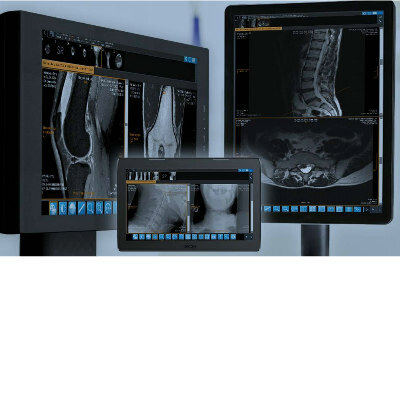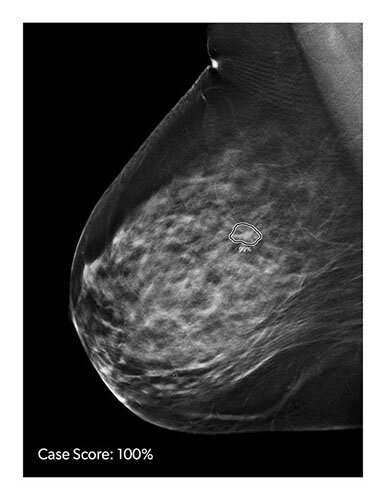Fujifilm Previews World's First Glass-Free Digital Radiography Detector at RSNA 2019 Image
|
By MedImaging International staff writers Posted on 02 Dec 2019 |

Image: Glass-Free Digital Radiography Detector (Photo courtesy of FUJIFILM Medical Systems U.S.A., Inc.)
FUJIFILM Medical Systems U.S.A., Inc. (Lexington, MA, USA) previewed its new FDR D-EVO III DR detector at the 105th scientific assembly and annual meeting of the Radiological Society of North America (RSNA) held from December 1 – 6, 2019 in Chicago, USA. FUJIFILM Medical Systems, which is part of the FUJIFILM Healthcare portfolio, is a provider of diagnostic imaging products and medical informatics solutions ranging from digital X-ray systems (DR: detectors, mobiles, rooms and 3D mammography), to the comprehensive Synapse Enterprise Imaging portfolio, to full-field digital mammography systems with digital breast tomosynthesis, and computed tomography solutions.
The FDR D-EVO III previewed at RSNA 2019 is FUJIFILM's third-generation digital X-ray detector featuring a sleek, thin design and status as the world's first glass-free DR detector with patented Irradiated Side Sampling (ISS) – also making it the world's lightest 14x17 detector at approximately four pounds. This innovative design removes the traditional glass substrate from the capture layer, eliminating the most fragile layer inside, allowing for a much lighter weight compared to previous models. The FDR D-EVO III 14x17 inch detector incorporates all of the groundbreaking features of the FDR D-EVO II, including its sleek design with smooth and tapered edges for easier positioning, antibacterial nano-coating to help fight against HAIs and a long-lasting battery life.
Additionally, FUJIFILM displayed its full range of DR detectors, including the CALNEO Dual, a 17x17 inch standard cassette sized detector featuring two sensitivity capture layers, coupled with its intelligent energy subtraction processing. A single exposure produces three images; traditional, soft tissue-only, and bone only views. These distinctly different images are expected to be used for visualizing or tracking of lung cancer nodules. The innovative dual capture layer design yields higher definition general X-ray images, enhancing separation accuracy of bone detail and soft tissue.
FUJIFILM also previewed the FDR SE Lite retrofit DR detector at RSNA 2019 that is geared towards bringing DR technology to specialty and small medical practices. Offered as an economical DR solution, the FDR SE Lite DR detector and its companion workstation offer just the right amount of features such as instant image transfer, simplified workflow, and shortened exam times (compared to computed radiography), to meet the unique needs of small practices. Users have the option of upgrading to include Dynamic Visualization II processing which adapts image contrast and density, based on image, thickness and structural recognition.
At RSNA 2019, FUJIFILM also demonstrated its full Synapse portfolio and debut its latest advancement in Enterprise Imaging, Synapse 7x which is a next-generation, secure server-side viewer platform that extends across enterprise imaging areas, bringing diagnostic radiology, mammography and cardiology together through a single, zero footprint platform, and allowing for immediate content interaction regardless of dataset size. Synapse 3D operates natively within the viewer, extending the same advanced visualization across radiology, cardiology, and mammography, eliminating the need for third-party workstations. Synapse 7x is designed to take full advantage of Fujifilm's open AI-enabled platform and use AI results natively within user workflows.
"Fujifilm's Synapse 7x promises to be a game changer for our US healthcare providers. It's a convergence of Fujifilm's server-side technology and was designed to cover all the different areas of diagnostic visualization as well as meet the long-term goal of providing the richest possible visualization layer for an enterprise imaging solution," said Bill Lacy, Vice President of Medical Informatics at FUJIFILM Medical Systems, U.S.A., Inc. "The robust technology is uniquely AI-enabled and integrated, and is presently unrivalled in the marketplace."
Related Links:
FUJIFILM Medical Systems U.S.A., Inc.
The FDR D-EVO III previewed at RSNA 2019 is FUJIFILM's third-generation digital X-ray detector featuring a sleek, thin design and status as the world's first glass-free DR detector with patented Irradiated Side Sampling (ISS) – also making it the world's lightest 14x17 detector at approximately four pounds. This innovative design removes the traditional glass substrate from the capture layer, eliminating the most fragile layer inside, allowing for a much lighter weight compared to previous models. The FDR D-EVO III 14x17 inch detector incorporates all of the groundbreaking features of the FDR D-EVO II, including its sleek design with smooth and tapered edges for easier positioning, antibacterial nano-coating to help fight against HAIs and a long-lasting battery life.
Additionally, FUJIFILM displayed its full range of DR detectors, including the CALNEO Dual, a 17x17 inch standard cassette sized detector featuring two sensitivity capture layers, coupled with its intelligent energy subtraction processing. A single exposure produces three images; traditional, soft tissue-only, and bone only views. These distinctly different images are expected to be used for visualizing or tracking of lung cancer nodules. The innovative dual capture layer design yields higher definition general X-ray images, enhancing separation accuracy of bone detail and soft tissue.
FUJIFILM also previewed the FDR SE Lite retrofit DR detector at RSNA 2019 that is geared towards bringing DR technology to specialty and small medical practices. Offered as an economical DR solution, the FDR SE Lite DR detector and its companion workstation offer just the right amount of features such as instant image transfer, simplified workflow, and shortened exam times (compared to computed radiography), to meet the unique needs of small practices. Users have the option of upgrading to include Dynamic Visualization II processing which adapts image contrast and density, based on image, thickness and structural recognition.
At RSNA 2019, FUJIFILM also demonstrated its full Synapse portfolio and debut its latest advancement in Enterprise Imaging, Synapse 7x which is a next-generation, secure server-side viewer platform that extends across enterprise imaging areas, bringing diagnostic radiology, mammography and cardiology together through a single, zero footprint platform, and allowing for immediate content interaction regardless of dataset size. Synapse 3D operates natively within the viewer, extending the same advanced visualization across radiology, cardiology, and mammography, eliminating the need for third-party workstations. Synapse 7x is designed to take full advantage of Fujifilm's open AI-enabled platform and use AI results natively within user workflows.
"Fujifilm's Synapse 7x promises to be a game changer for our US healthcare providers. It's a convergence of Fujifilm's server-side technology and was designed to cover all the different areas of diagnostic visualization as well as meet the long-term goal of providing the richest possible visualization layer for an enterprise imaging solution," said Bill Lacy, Vice President of Medical Informatics at FUJIFILM Medical Systems, U.S.A., Inc. "The robust technology is uniquely AI-enabled and integrated, and is presently unrivalled in the marketplace."
Related Links:
FUJIFILM Medical Systems U.S.A., Inc.
Latest RSNA 2019 News
- Carestream Introduces Three-Dimensional Extension of General Radiography Through Its Digital Tomosynthesis Functionality
- Lunit Demonstrates Latest Updated AI Solutions for Chest and Breast Radiology at RSNA 2019
- Bracco Diagnostics Unveils Contrast Media and Device Offerings at RSNA 2019
- Guerbet Showcases New Dose&Care and Other Digital Solutions with Diagnostic and Interventional Imaging Offerings
- Canon Introduces New Wireless Detectors and Digital PET/CT Scanner at RSNA 2019
- Siemens Healthineers Introduces SOMATOM On.site Mobile Head CT Scanner and AI-based MRI Assistants at RSNA
- Hologic Launches Unifi Workspace, Comprehensive Reading Solution for Breast Health Diagnostics
- Agfa Launches New Groundbreaking Digital Radiography Unit at RSNA 2019
- Fujifilm SonoSite Exhibits Complete Point-of-Care Ultrasound Portfolio at RSNA 2019
- NVIDIA Showcases Latest AI-driven Medical Imaging Advancements at RSNA 2019
- Philips Healthcare Demonstrates How AI Breast Software Brings Intelligence and Automation to Breast Ultrasound
- Siemens Healthineers Focuses on Digital Transformation of Imaging and Therapy at RSNA 2019
Channels
Radiography
view channel
Novel Breast Imaging System Proves As Effective As Mammography
Breast cancer remains the most frequently diagnosed cancer among women. It is projected that one in eight women will be diagnosed with breast cancer during her lifetime, and one in 42 women who turn 50... Read more
AI Assistance Improves Breast-Cancer Screening by Reducing False Positives
Radiologists typically detect one case of cancer for every 200 mammograms reviewed. However, these evaluations often result in false positives, leading to unnecessary patient recalls for additional testing,... Read moreMRI
view channel
PET/MRI Improves Diagnostic Accuracy for Prostate Cancer Patients
The Prostate Imaging Reporting and Data System (PI-RADS) is a five-point scale to assess potential prostate cancer in MR images. PI-RADS category 3 which offers an unclear suggestion of clinically significant... Read more
Next Generation MR-Guided Focused Ultrasound Ushers In Future of Incisionless Neurosurgery
Essential tremor, often called familial, idiopathic, or benign tremor, leads to uncontrollable shaking that significantly affects a person’s life. When traditional medications do not alleviate symptoms,... Read more
Two-Part MRI Scan Detects Prostate Cancer More Quickly without Compromising Diagnostic Quality
Prostate cancer ranks as the most prevalent cancer among men. Over the last decade, the introduction of MRI scans has significantly transformed the diagnosis process, marking the most substantial advancement... Read moreUltrasound
view channel
Deep Learning Advances Super-Resolution Ultrasound Imaging
Ultrasound localization microscopy (ULM) is an advanced imaging technique that offers high-resolution visualization of microvascular structures. It employs microbubbles, FDA-approved contrast agents, injected... Read more
Novel Ultrasound-Launched Targeted Nanoparticle Eliminates Biofilm and Bacterial Infection
Biofilms, formed by bacteria aggregating into dense communities for protection against harsh environmental conditions, are a significant contributor to various infectious diseases. Biofilms frequently... Read moreNuclear Medicine
view channel
New SPECT/CT Technique Could Change Imaging Practices and Increase Patient Access
The development of lead-212 (212Pb)-PSMA–based targeted alpha therapy (TAT) is garnering significant interest in treating patients with metastatic castration-resistant prostate cancer. The imaging of 212Pb,... Read moreNew Radiotheranostic System Detects and Treats Ovarian Cancer Noninvasively
Ovarian cancer is the most lethal gynecological cancer, with less than a 30% five-year survival rate for those diagnosed in late stages. Despite surgery and platinum-based chemotherapy being the standard... Read more
AI System Automatically and Reliably Detects Cardiac Amyloidosis Using Scintigraphy Imaging
Cardiac amyloidosis, a condition characterized by the buildup of abnormal protein deposits (amyloids) in the heart muscle, severely affects heart function and can lead to heart failure or death without... Read moreGeneral/Advanced Imaging
view channel
New AI Method Captures Uncertainty in Medical Images
In the field of biomedicine, segmentation is the process of annotating pixels from an important structure in medical images, such as organs or cells. Artificial Intelligence (AI) models are utilized to... Read more.jpg)
CT Coronary Angiography Reduces Need for Invasive Tests to Diagnose Coronary Artery Disease
Coronary artery disease (CAD), one of the leading causes of death worldwide, involves the narrowing of coronary arteries due to atherosclerosis, resulting in insufficient blood flow to the heart muscle.... Read more
Novel Blood Test Could Reduce Need for PET Imaging of Patients with Alzheimer’s
Alzheimer's disease (AD), a condition marked by cognitive decline and the presence of beta-amyloid (Aβ) plaques and neurofibrillary tangles in the brain, poses diagnostic challenges. Amyloid positron emission... Read more.jpg)
CT-Based Deep Learning Algorithm Accurately Differentiates Benign From Malignant Vertebral Fractures
The rise in the aging population is expected to result in a corresponding increase in the prevalence of vertebral fractures which can cause back pain or neurologic compromise, leading to impaired function... Read moreImaging IT
view channel
New Google Cloud Medical Imaging Suite Makes Imaging Healthcare Data More Accessible
Medical imaging is a critical tool used to diagnose patients, and there are billions of medical images scanned globally each year. Imaging data accounts for about 90% of all healthcare data1 and, until... Read more
Global AI in Medical Diagnostics Market to Be Driven by Demand for Image Recognition in Radiology
The global artificial intelligence (AI) in medical diagnostics market is expanding with early disease detection being one of its key applications and image recognition becoming a compelling consumer proposition... Read moreIndustry News
view channel
Bayer and Google Partner on New AI Product for Radiologists
Medical imaging data comprises around 90% of all healthcare data, and it is a highly complex and rich clinical data modality and serves as a vital tool for diagnosing patients. Each year, billions of medical... Read more






















